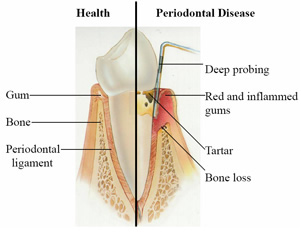How is periodontal disease measured?
Periodontal disease is measured using a periodontal probe. This is a blunt ended instrument used to assess the depth and width of any pockets between your gum and tooth. Periodontal disease is diagnosed if:
- Pockets are 5mm or deeper.
- Pockets bleed during careful assessment. This is a sign of active infection.

Treatment of gingivitis is usually completed by scaling your teeth, oral hygiene advice and tooth brushing instructions.
Regular appointments to ensure effective plaque removal and healthy gums will follow this appointment.
Once periodontitis has begun to progress the treatment is as follows:
- Full mouth root planing and removal of plaque retaining factors. This involves scaling the roots of all your teeth, usually completed using local anaesthetic. Your dentist and hygienist may also decide to use antibiotics in any infected pockets at this stage. Any obvious plaque retaining factors are removed to allow easier plaque removal. Tooth brushing instruction and inter dental cleaning are demonstrated. This usually involves 4-5 half hour visits with your hygienist.
- This will be followed with a review appointment. After full mouth root planning your teeth and gums are reassessed six weeks after full mouth root planing. If there is any persistent bleeding, either with tooth brushing or probing, or any pockets 5mm or deeper, further treatment will be recommended.
- In exceptional cases where your gum condition is failing to stabilise, your dentist may recommend that you see a periodontist.
